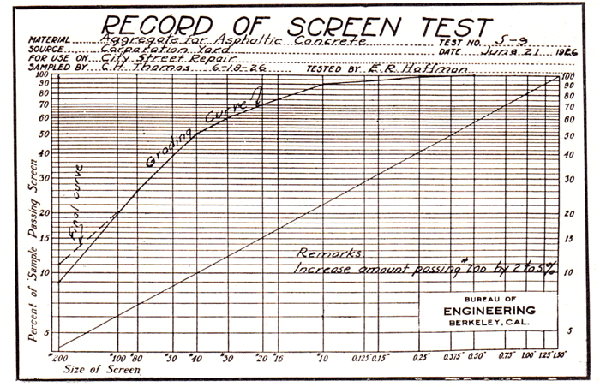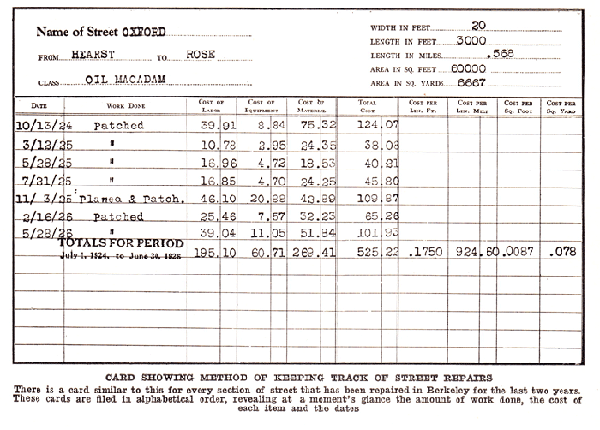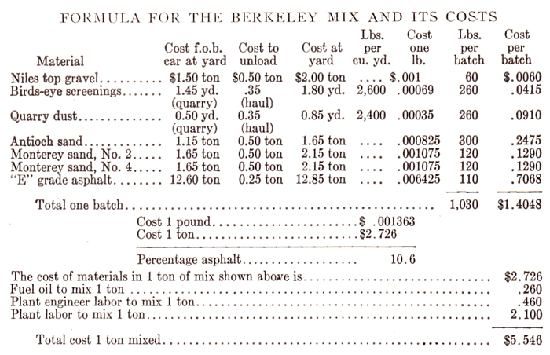
Street Maintenance in the
City of Berkeley 1927
The Value of Detailed Cost Data on Street Maintenance
By Colonel A. J. Eddy, City Engineer and Superintendent of Streets, Berkeley, California.Modern business methods, in industry and commerce, demand an accurate day-to-day accounting of every detail that sums up into operating expense. The inner workings of a successful corporation are largely dependent for daily progress and for intelligent expansion on the most minute calculations in the hands of efficiency experts and cost accountants. There is no reason why this factor should be neglected in city administration, or why some form of intelligible compilation of cost data should not be applied to any department of city government that spends the public's money.
In Berkeley, California, the Department of Public Works has developed a system of maintaining cost data that has led to concrete results, especially in regard to street maintenance. Up to January, 1926, it had not been possible to obtain accurate cost data because of our inadequate system of bookkeeping. At this time, J. P. Langan was employed to take charge of all bookkeeping and cost finding, and he has reorganized our system so that accurate costs are now being obtained.
It was formerly the practice to charge materials against the various functions, or against the classes of work for private parties at the time those materials were requisitioned. This led to considerable error because it was impossible to prophesy, at the time a requisition was made out, just how the various materials were going to be expended on actual work.
New Accounting Method
At the end of the fiscal year, a Public Works Stock Account was inaugurated in the Department, and all requisitions for new materials are charged against this account. When the materials are actually used, they are charged against the particular job or function of the Department, so that now actual and intelligible costs on all classes of work are being obtained.
The Berkeley Department of Public Works has this simple and effective method of handling all complaints. This card is made out in duplicate when the complaint is received. One copy is filed and the other is given to the proper department for handling the complaint
In connection with the "work for private parties" mentioned above, it might be explained that the total amount of work handled by the Department of Public Works in Berkeley - is not reflected in the budget appropriation. This, in fact, is only a small part of the total. In addition to the budget there are commercial enterprises called "work for private parties," and they include laying lateral sewers, resurfacing of trenches, and other property improvements. Also, the Department handles all street improvements, whether public or private, for which are furnished engineering, supervision, inspection and assessment rolls. In all, more than $500,000 worth of work was directed by this department in the fiscal year 1925-1926, but the budget appropriation amounted only to $152,627.11.
The most important result of our method of keeping cost data on street maintenance in Berkeley has been to demonstrate clearly that the greater cost of maintaining oil macadam pavements makes it profitable for us to pave our streets as soon as possible with permanent hard-surface pavements.
We can show to the City Council or to the City Manager or to the public just what streets are most in need of hard surfacing, and how much ought to be done at any given time, and we can tell them, in the clearly understandable language of dollars and cents, why it ought to he done.
The figures we keep show immediately whether or not an excessive amount is being spent for maintenance of the oil-macadam surface. If it is excessive, then this street, having probably the most traffic, should be replaced with hard-surface pavement.
For example, the tabulation below, contained in the Department's recent Annual Report, shows a list of five streets characterized as arterial highways, which are built of oil-macadam, and which are inadequate for the traffic they carry.
The last item in the tabulation shows the cost of maintaining a hard-surface pavement which is comparable in volume of traffic to the old-macadam samples above it. Thus we were able to show the city that it costs thirty-one times as much to maintain the portion of Spruce Street, the first on the list, as it does to maintain a typical hard-surface pavement; and also that this particular section of Spruce Street cost five times as much as the average of oil-macadam streets for the fiscal year. Obviously, Spruce Street is the one that needs the hard surface first.
ARTERIAL HIGHWAYS OF OIL-MACADAM WHICH ARE INADEQUATE FOR TRAFFIC Street From To Length
in MilesCost for
2 YearsCost per
Mile per yearSpruce St. Los Angeles Rose .388 $1,278.21 $1,645.00 Three Alameda Monterey Solano .227 593.44 1,307.00 Solano Ave. Alameda Tulare .298 617.20 1,034.00 Euclid Ave. Eunice Regal Rd. .740 791.00 535.00 Ashy Ave. Adeline San Pablo .938 945.73 504.00 Hard Surface University Ave. Third Grove 1.55 164.06 53.00 Much of the task of keeping the cost data is a matter of bookkeeping, although several points of presentation have been developed which might be worth mentioning. Mainly, data on Berkeley streets are kept by means of a card index system. A sample of a card filled out for a typical street is reproduced with this article. These cards are filed alphabetically. The system has proved simple and accurate.
In addition to the card index, which is always close at hand, there is available in the City Engineer's office a street map of the city. The streets are marked in colors, different colors for streets that have been repaired one, two, three, or four times. Thus I know at a glance that the red streets on the map are costing the most for repairs and the yellow ones least. The map is always kept up to date.
Most of our macadam streets were built for horse-drawn vehicles. Later these streets were surface-oiled with road oil to make them suitable for automobiles. But as in any other city, truck traffic in Berkeley is continually on the increase, and this with increased automobile traffic makes maintenance a hard problem.
Berkeley should have at the present time between 60 and 70 miles of paved streets, or approximately 35 per cent of the total mileage. The problem is to increase the present mileage as rapidly as possible, and particularly to replace the oil-macadam on those streets that carry a great deal of through traffic, and are really arterial highways. The following table shows the mileage of hard-surface pavements, oil - macadam pavements, and unimproved streets for the last three years.
| Type | 1924 | 1925 | 1926 |
| Hard-surface pavements | 18.9 | 19 | 21 |
| Oil-Macadam pavements | 163.7 | 164 | 162 |
| Unimproved streets | 10.2 | 10 | 10 |
| Totals | 192.8 | 193 | 193 |
The oil-macadam pavement is constructed of crushed rock grading from 2.5-inch maximum diameter down to stone dust, which is compacted with a roller which weighs not less than 400 pounds per lineal inch width of tread. Two oilings are used, the first being one gallon per square yard of street surface and the second 3/8 of a gallon per square yard of surface. The resulting pavement is 6 inches thick.
Two types of hard-surface pavements have been used. For the downtown section a 6-inch cement-concrete base is laid, with a 2-inch asphaltic concrete top. For main arteries in the residential districts a plain cement-concrete pavement is used, 1:2:4 mix, with either a 6 or a 7-inch thickness, depending upon the character of sugared and traffic.
 |
| SCREEN TEST FOR THE BERKELEY MIX |
Hot Asphalt Patching
C. H. Thomas, Assistant Superintendent of Streets, has developed a hot asphalt mixture for patching asphalt pavements which is worthy of description. It is a combination of aggregate about midway between sheet asphalt and Topeka mix which is called the "Berkeley mix," and a method of repairs which is called the "Berkeley method."
The old method of smoothing bumps from asphalt pavements by means of a surface heater was a practice which could not be continued, because each time the pavement was treated, approximately a quarter of an inch of the surface was burned and removed. The "Berkeley method" of adding new material to the old builds it up instead of tearing it down.
This method has been in use for sixteen months, and repairs have been made on College Avenue from Bancroft to Alcatraz, Telegraph Avenue from Allston to Dwight Way, Adeline Street from Ward to the south city line, Shattuck Avenue and Grove Street throughout almost their entire length, Euclid Avenue from Rose Street to Ridge Road, and University Avenue from Grove to Shattuck. The patches are finished off with a slightly roughened surface so as to prevent automobiles from skidding.
Repairs by this method cost 4 cents a square foot, approximately the same as by the old surface heating methods. Results, however, are much better, and the life of the paving will be increased.
It is Mr. Thomas' opinion that bumpy asphalt surfaces are caused by too soft an asphalt in the original mix, and the "Berkeley mix" was therefore made as hard as possible to overcome the effect of the softer underlying material.
Office Procedure
In addition to the careful planning and recording of cost data on street maintenance, there are other office methods and means of keeping track of what goes on, that are of importance in relation to the Department of Public Works.
For example, the normal routine of this department involves the handling of a great many complaints that come in daily, regarding defective sewers, sidewalks, pavements, etc. This year a new blank form has been devised for the purpose of handling these complaints promptly and with the least amount of trouble.
A sample of the complaint form is reproduced with this article.
This form is executed in duplicate by the clerk who handles the complaint, and then is referred to the proper person for disposition; for example, street-light complaints are referred to the Electrical Engineer, complaints on pavements to the Assistant Superintendent of Streets, etc. A duplicate is kept in the office as a follow-tip, and the complaint is filed when properly disposed of. This system not only facilitates handling the complaints, but gives a means of classifying the various kinds. Many complaints registered in one department usually means that something is seriously wrong with that department.
A decided advance has been made in all street-paving improvement by requiring public utility concerns to install, in advance of paving, new water services, gas services, etc., with new mains where necessary. Thus, paving will not have to be torn up except for unforeseen contingencies. Local sewers are also provided in the plans for the same purpose and laid from the main sewer to the curb, so that house connections for new buildings can be installed at any time. This not only saves the pavement, but cuts down maintenance costs and eliminates inconvenience to the motoring public, which always occurs when streets are opened for any purpose.
A convenient method has also been devised for keeping track of all open trenches in the streets, so that the number of trenches open at one time will not be too great. Ordinances provide that the work of backfilling and resurfacing these trenches must he done to the satisfaction of the Superintendent of Streets, and corporations are permitted to backfill and resurface their own trenches under city inspection if they so desire.
One of the charts used in keeping track of open trenches is shown in an illustration above.These methods of office administration made it possible this year to boil down our recommendations to the City Manager in the Annual Report of the Department of Public Works to include just what could be shown to be most necessary. The main recommendation was that a definite program should be adopted by the City Council for building five or six miles of hard-surface pavement each year, and that those macadam streets should be selected for improvement which are now most expensive to maintain.
All Rights Reserved

